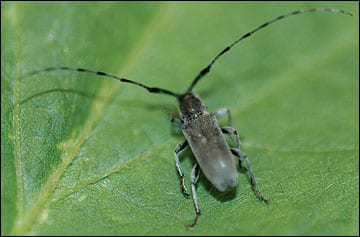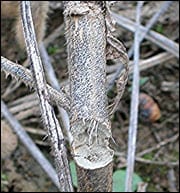 The soybean stem borer (Dectes texus) is a long horn beetle that can cause lodging in soybean plants, resulting in harvest difficulties and significant yield loss.
The soybean stem borer (Dectes texus) is a long horn beetle that can cause lodging in soybean plants, resulting in harvest difficulties and significant yield loss.
“In Nebraska and other parts of the soybean growing areas, we are seeing a heavy infestation of stem borer,” said AgVenture Seed and Technology Manager Louis Sutton. “Many growers are not aware that they have issues with this pest, which will affect yield. Farmers may be disappointed with the crop and stem borer, rather than the weather, could be the cause of moving yields off target.”
 Adult stem borers emerge in late June to August and the larval stage lasts from September through early June. Adult females lay eggs into stems at leaf attachment points and hatched larvae bore into the stem and begin feeding on pith. Feeding damage can reduce the plant’s ability to transfer water and soil nutrients to developing pods and seeds. Larvae are a light cream color, cylindrical shaped, and ½ inch long. In late summer, larvae move to the base of the soybean plant, about 2 inches above the soil surface, and plug the stem with their frass to create a cell in which to overwinter. This is the girdling stage and can increase lodging, especially with wind and heavy rains.
Adult stem borers emerge in late June to August and the larval stage lasts from September through early June. Adult females lay eggs into stems at leaf attachment points and hatched larvae bore into the stem and begin feeding on pith. Feeding damage can reduce the plant’s ability to transfer water and soil nutrients to developing pods and seeds. Larvae are a light cream color, cylindrical shaped, and ½ inch long. In late summer, larvae move to the base of the soybean plant, about 2 inches above the soil surface, and plug the stem with their frass to create a cell in which to overwinter. This is the girdling stage and can increase lodging, especially with wind and heavy rains.
 Fields should be monitored for the presence of beetles and checked in at least five locations. When beetles lay eggs in the stem, the associated leaf will eventually wilt and die. When scouting, pay extra attention to fields that were planted early or planted to a shorter season variety. If 50% of the checked plants have stem borer damage, the field is at risk for significant stand loss (University of Nebraska-Lincoln).
Fields should be monitored for the presence of beetles and checked in at least five locations. When beetles lay eggs in the stem, the associated leaf will eventually wilt and die. When scouting, pay extra attention to fields that were planted early or planted to a shorter season variety. If 50% of the checked plants have stem borer damage, the field is at risk for significant stand loss (University of Nebraska-Lincoln).
The best way to manage larval infestations is by harvesting infested fields as soon as mature beans are dry enough to be processed by a combine. Other management considerations include crop rotation, planting longer season soybean varieties, and planting a plant trap crop.
Sutton recommends a plant trap crop of sunflowers next to the soybean field to control infestation. The beetles prefer to lay eggs in sunflowers, thus reducing the number found in the adjacent soybean field. University field studies conducted in Tennessee showed that fall tillage significantly increased overwintering mortality (University of Missouri).
Your AgVenture Yield Specialist can help you scout for soybean stem borer and create an action plan to manage infestations. For additional information, please contact your AgVenture Seed and Technology Manager.
Sources: University of Nebraska-Lincoln, University of Missouri Extension
Photos: University of Nebraska-Lincoln; Michael L. Boyd; Scott Stewart, University of Tennessee.